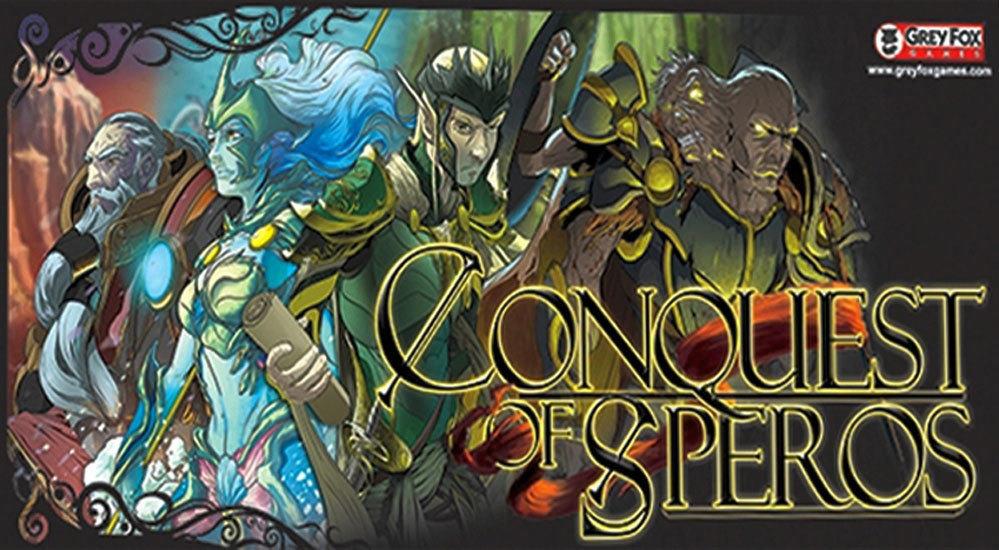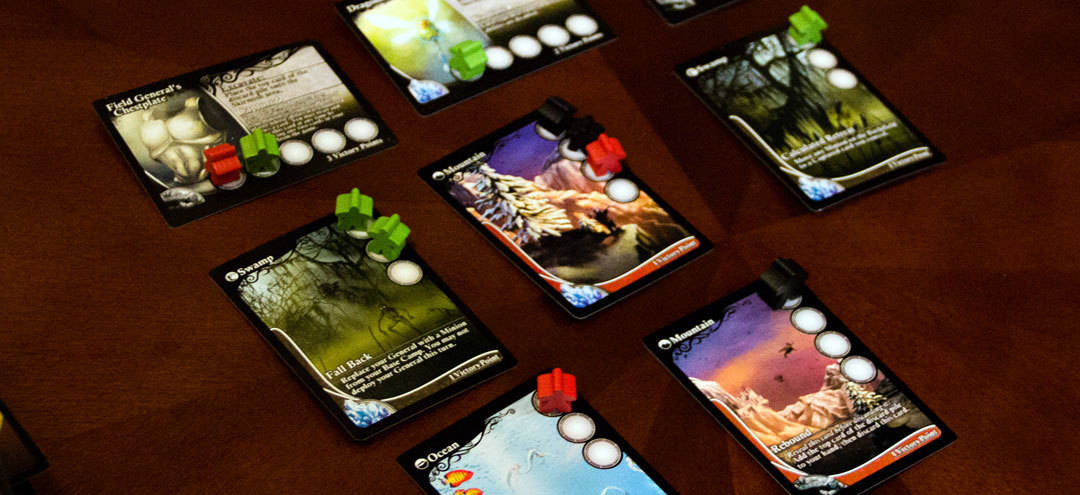 In the last few years, “filler games” have become a buzzword within the board gaming hobby. Depending on your point of view, filler games can provide a nice break between larger games, or be used to introduce new gamers to the hobby. Or you may see them as short, pointless, boring affairs with few, if any, decisions to make.
In the last few years, “filler games” have become a buzzword within the board gaming hobby. Depending on your point of view, filler games can provide a nice break between larger games, or be used to introduce new gamers to the hobby. Or you may see them as short, pointless, boring affairs with few, if any, decisions to make.
While both may be true to some respects, Conquest of Speros seemed to position itself as a filler game with a little more meat to it. It’s a full-fledged area control game with variable player powers, significant amounts of unique art, and promises to play in about 30 minutes for 2-4 players.
Game Overview:
In Conquest of Speros, each player will take control of one of four different factions and battle for various locations. Location types and resources from those locations translate into points at the end of the game, with the player having the most points being crowned the winner.
Game Components:

As far as components, Conquest of Speros is mainly composed of a whole lot of cards. There are 80 location cards, 18 artifact cards, 12 mastery objectives, and 17 bonus objective cards. The card quality is merely ok, they are a bit thin and slightly prone warping pretty easily.
Although there are only 4 types of locations, there are various pieces of art so the same location type doesn’t always have the same art. They aren’t all unique, but there is enough variety that it doesn’t get entirely boring. That said, the art style didn’t resonate much with me, it seems a little flat and just didn’t do much to make the game stand out.
There are also 11 minions for each player color. Ten of those minions are small and one “general” minion that is larger and has a few special rules associated with it. Although these are fairly standard meeples, I would have liked the size difference between the general and the regular minion to be more significant. Unless they are right next to each other, it can be difficult to tell them apart.
All in all, the game is certainly playable and the components aren’t going to detract from the experience significantly, but they aren’t adding much either.
How To Play:
To begin, each player chooses a faction and gets 8 location cards in their hand and their supply of 10 minions as well as their general meeple. There are four factions: Merfolk, Undead, Dwarves, and Elves.

Each faction is “familiar” with one of the terrain types – the elves with the forest locations, for instance. The location cards are used throughout the game and have multiple uses. Each card has an event, a resource, and a number of spaces for minions to be deployed throughout the game.
Players will also receive three bonus objective cards. These are personal objective that will reward additional points, but only one of the three cards can be added to your scoring at the end of the game.
Each turn consists of basically two steps. First, the active player discards a location card from their hand. They may, but aren’t required to perform the event on that card. These actions can allow you to move minions, draw extra cards, or return your general from another location back to your supply.
In the second step, you may choose one of four available actions:
- Explore – Take a location card from your hand and place it face up in the Skirmish Area. If it is your race’s “familiar terrain” you may also deploy one of your minions to that area.
- Attack – Deploy one of your minions to any location already in the Skirmish Area. You can also deploy your minions to an Ancient Artifact card that gives special abilities.
- Lead – Deploy your general and another minion to any location in the Skirmish Area.
- Plan – Draw three cards.
If, after your action, your minions are deployed on the majority of spaces for a location, you claim that location and it is removed from the Skirmish Area. Minions, both yours and those of other players, will stay on that location even though you have claimed it. Each location has a resource (gold, iron, or crystal) and a victory point value.
This continues until a player starts their turn with no minions left in their supply or the location deck is exhausted. Players score points for their claimed locations, each minion deployed to a location, and for unique sets of the three resource types on locations they have claimed. Each player also earns points from their personal objectives and the mastery objectives that were revealed during setup. The player with the most points wins.

Game Experience:
Conquest of Speros really seems to pull off a fairly intricate game in a small box that plays in 30 minutes. There are parts of it that work extremely well. I’m a huge fan of multi-use cards and Conquest of Speros makes great use of them here. Each card has to be evaluated for the event on it, the location type, the resource, the victory points, and the number of minions needed to claim it. All of that information goes into making the decisions on which cards to discard for the event, which to play to the Skirmish Area, and which to deploy your minions to.
The bonus objectives, mastery objectives, and artifact cards all add some amount of tactics to the gameplay. You aren’t necessarily always best off going after familiar terrain for your faction as the objective cards end up being a significant portion of your score at the end of the game.
Unlike many area control games, there is no limit to the number of areas you can have in the Skirmish Area. So in many cases, it seemed to lack the tension that you often get trying to claim an area before your opponent since you could just put a new location down and start going after that one. This is especially pronounced with fewer players.

The events on the location cards can be extremely powerful. For instance, the Obliterate event allows you to remove an enemy minion from your familiar terrain from the game entirely. This can be from a card in the Skirmish Area or a location that has already been claimed. The Fall Back action allows you to reclaim your General after he has already been deployed.
Other events are less powerful, allowing you to draw a card or reclaim a card from discard. Getting the right events at the right time and really swing the game and have been more important than actually going after the right locations at the right time.
Final Thoughts:
Conquest of Speros is a decent area control game and provides a fairly deep experience in an incredibly small box. When it’s all said and done, I’m just not sure how useful that is. It certainly doesn’t have the usefulness of a filler game that can be played quickly without much thinking involved. The times we want to play something that feels like a “big box” game, we’d just pull out a big box game because for all that is has going for it, Conquest of Speros doesn’t completely replicate that feel.
There are definitely lots of decisions to make in Conquest of Speros, they just aren’t terribly difficult decisions. The good events are so good… you would never use an Obliterate card for anything other than the event printed on it. The bad events are so bad that you almost always use them as locations. This, coupled with the fact that you can just keep adding new locations and generally stay out of the way of other players make the game lack tension and interest.
Ultimately, I think Conquest of Speros was very close to being a very good game. It just falls a little short. I’m a sucker for multi-use cards and it provides a quick introduction to area control games for newer or less experienced gamers. Unfortunately it all just seems a little out of balance and won’t get this to the table because of it.
If you’d like to pick up a copy of Conquest of Speros, you can get it for about $25.
Rating: 2.5 Stars – While Conquest of Speros has some good things going for it, it has a few quiks that hold it back from being an overall good game.
 Hits:
Hits:
• Multi-use cards are a great mechanic and used smartly in this game
• Packs a lot of decisions into a 30 minute game
Misses:
• Rarely are players trying to control the same areas
• Component quality is just borderline OK
• Huge disparity in quality of events from location cards






















